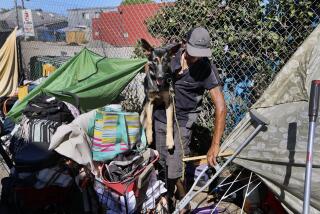Deputies Mean Quicker Police Response in L.B., Officials Say
- Share via
LONG BEACH — When sheriff’s deputies begin patrolling two sections of the city next month, residents will notice more than just a change in the color of the uniforms. For the first time in years, residents across the city will see faster and better service, officials predict.
The impact should be felt immediately in the northern and northeastern sections of town, where 46 deputies in khaki-and-olive-drab uniforms will be replacing city police dressed in navy blue, officials said.
The City Council last week approved a four-year, $19.9-million contract with the Sheriff’s Department to bolster the town’s understaffed Police Department and bring down skyrocketing crime.
“Without a doubt, we’ll get better service,” said Councilman Les Robbins, whose district includes the northeastern section that deputies will begin patrolling Oct. 15.
While it takes Long Beach police an average of seven minutes to respond to emergency calls, sheriff’s deputies respond in about three minutes in their jurisdictions, according to officials from both agencies.
The Long Beach Police Department, which is strapped for officers, has been forced to cut back on responses to some calls. The department will not dispatch a patrol car to the scene of burglaries or thefts unless callers indicate that they think suspects are still in the area, according to police Lt. Melvin Gallwas.
The department also does not typically dispatch a unit to a car accident in which no one is injured, unless the crash poses a traffic hazard, Gallwas said. Instead, a crime report is taken over the telephone or at the station.
The Sheriff’s Department, on the other hand, attempts to send a patrol car if one is requested, regardless of the nature of the call.
“Whether it’s a stolen bicycle or a murder or anything in between, we send somebody to them--with rare exception,” Sheriff’s Cmdr. John Hammargren said.
One exception would be a request by an insurance company for a crime report, he said.
Councilman Doug Drummond, a retired Long Beach police commander, said: “With the sheriff’s (deputies) patrolling up there, I’m sure they’ll have more service and more patrols.”
Police Chief Lawrence Binkley said he also expects the department’s response time to drop throughout the rest of the city, because the deputy patrols will allow the department to reassign 43 city officers now working in areas north of Market Street and in the city’s northeast, north of Spring Street and east of Lakewood Boulevard.
“We’ll get backup reinforcement in the rest of the city,” Binkley said. “It’s great. There’s no doubt in my mind that it will improve public safety.”
City Manager James Hankla predicted that city police will also be able to respond in person to more calls.
“We’ll have more officers to deploy,” he said. “The reason you don’t respond to certain types of calls is that you don’t have enough officers. I suspect with the increase in manpower, these differences will be blurred in the future.”
Deputies will have different priorities in the northeastern part of town, which makes up most of the 5th Council District, and the northern section of Long Beach, which covers the 9th District and a small part of the 8th District.
Councilman Robbins, who is a deputy sheriff, said that because northeastern Long Beach has the lowest crime rate in the city, deputies will place less emphasis on law enforcement “and more on police presence, more on prevention, because we don’t have hard-street crime out here.
“Right now, we don’t have anybody out here,” said Robbins, noting that police officers are often called away from his quiet district to respond to more urgent calls in other parts of the city.
Deputies patrolling the middle-class neighborhoods in northeast Long Beach, which has the highest percentage of senior citizens in the city, also will probably be more involved with neighborhood monitoring programs, Hammargren said.
“We want high visibility,” Hammargren said. “There will be a lot more non-law-enforcement contacts, such as stopping and talking with people while they’re washing their cars.”
In the northern section--which includes a mixture of middle-class homes, crowded apartment complexes, shabby commercial strips and more crime--deputies will be responding to more emergency calls and focusing more on arresting suspected gang members, Hammargren said.
“We have to take some people off the street,” he added.
The Sheriff’s Department will provide 29 deputies in the north and 17 in the northeast.
To prepare for the deputies’ arrival in Long Beach, sheriff’s officials plan to ask the telephone company to reroute 911 calls to their dispatch center in Lakewood, said Sheriff’s Division Chief Ray Morris, who oversees southeast Los Angeles County.
Residents in the north and northeastern areas will also receive notices about the changeover in one of their city bills, Hammargren said. City and sheriff’s officials also plan to coordinate community meetings, and Sheriff’s Explorers may distribute informational flyers door to door, he said.
Law enforcement officials said they do not foresee problems in dividing the city between two agencies.
“The Sheriff’s (Department) already works in Long Beach,” Binkley said. “They serve search warrants, they work narcotics, they patrol the Blue Line. . . . I predict some little glitches, but we’ll have to work them out.”
Hammargren said: “We and the Long Beach Police Department already interact and work together. In pursuits, of course, you always cross over. . . . We just changed the boundaries a little.”
A sheriff’s lieutenant, who will will report to the station commander of the Lakewood sheriff’s station, will serve as a liaison for the agencies, officials said.
The plan calls for the deputies to be deployed out of the Long Beach Police Academy. The Police Department’s Metro Unit, a specialized enforcement team, is based there, but officials plan to move it to the former Southern California Edison facility at Hill Street and Santa Fe Avenue. That more central location will reduce the unit’s response time, police said.
It will cost $350,000 to refurbish the former Edison facility and $150,000 to prepare the academy for the deputies, according to a report by the city manager.
Meanwhile, Long Beach police administrators plan to continue recruiting new officers. A new batch of 12 recruits will begin training Oct. 8. Although the department is budgeted for 691 officers, it actually has 580 working. In addition, 43 police officers are eligible to retire in December.
And the crime rate continues to escalate. For example, there have been 81 murders so far this year, up from 63 during the same period last year, police said.
The city manager and City Council decided to contract with the Sheriff’s Department rather than a more time-consuming effort to hire and train more police officers. The cost of a deputy is also lower, they said.
“The bottom line is that we need law enforcement officers, and we need them now,” Councilman Jeff Kellogg said.
But the council’s approval of the sheriff’s contract has angered a some community groups, whose members are concerned about losing the ability to review complaints of police brutality. The local chapter of the National Assn. for the Advancement of Colored People, among others, complained that the actions of deputies, who are county employees, cannot be reviewed by the newly created city Citizen Police Complaint Commission.
Before the contract expires in 1994, most city officials said, they want to see the Police Department expanded and ready to resume patrolling the entire city.
More to Read
Sign up for Essential California
The most important California stories and recommendations in your inbox every morning.
You may occasionally receive promotional content from the Los Angeles Times.










